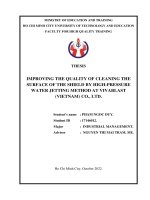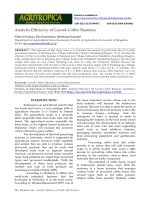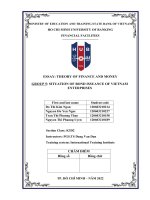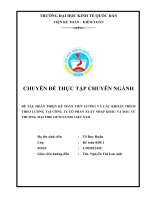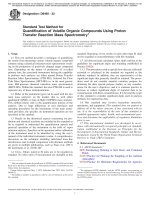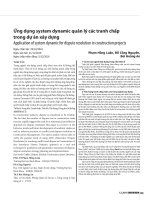- Trang chủ >>
- Khoa Học Tự Nhiên >>
- Vật lý
51649 physics of mass final
Bạn đang xem bản rút gọn của tài liệu. Xem và tải ngay bản đầy đủ của tài liệu tại đây (2.75 MB, 299 trang )
Physics of Mass
www.pdfgrip.com
This page intentionally left blank.
www.pdfgrip.com
Physics of Mass
Edited by
Behram N. Kursunoglu
Global Foundation, Inc.
Coral Gables, Florida
Stephan L. Mintz
Florida International University
Miami, Florida
and
Arnold Perlmutter
University of Miami
Coral Gables, Florida
Kluwer Academic Publishers
New York, Boston, Dordrecht, London, Moscow
www.pdfgrip.com
eBook ISBN:
Print ISBN:
0-306-47085-3
0-306-46029-7
©2002 Kluwer Academic Publishers
New York, Boston, Dordrecht, London, Moscow
Print ©1998 Kluwer Academic Publishers
New York
All rights reserved
No part of this eBook may be reproduced or transmitted in any form or by any means, electronic,
mechanical, recording, or otherwise, without written consent from the Publisher
Created in the United States of America
Visit Kluwer Online at:
and Kluwer's eBookstore at:
www.pdfgrip.com
PREFACE
The 26th Conference on Orbis Scientiae 1997 is the second in this series of high
energy physics and cosmology that took place in the month of December instead of the
well established tradition where the month of January was the conference date. This
change was due to the increased hotel rates in South Florida. Another change in the
organization of these conferences is the choice of a core topic to take half of the
conference time. The remaining time will be devoted to subjects of direct interest to
participants. In the 1997 Orbis Scientiae we chose “Physics of Mass” as the core topic of
the conference, which took over five sessions. The remaining five sessions were devoted
to those presentations of direct interest to some of the participants.
The Orbis Scientiae 1998 will cover “The Physics of Spin” as a core topic. In
anticipation of the ascending importance of gravity research in the 21st century, for the
core topics for the Orbis Scientiae 1999 and 2000 we suggest “The Status of An Evolving
Cosmological Parameter” and The Nature of Gravity from Big Bang to Flat Universe”,
respectively. These two topics may be expected to lead on to the first conference in the
21st century in which the core topic should be chosen for the Orbis Scientiae 2001 by the
participants. We are pleased to invite the conference participants to send us their choices
of core topics.
”
The Trustees and the Chairman of the Global Foundation, Inc., wish to extend
special thanks to Edward Bacinich of Alpha Omega Research Foundation for his
continuing generous support including the 1997 Orbis Scientiae.
Behram N. Kursunoglu
Stephan L. Mintz
Arnold Perlmutter
Coral Gables, Florida
April 1998
www.pdfgrip.com
ABOUT THE GLOBAL FOUNDATION, INC.
The Global Foundation, Inc., which was established in 1977, utilizes the world’s
most important resource... people. The Foundation consists of great senior men and
women of science and learning, and of outstanding achievers and entrepreneurs from
industry, governments, and international organizations, along with promising and
enthusiastic young people. These people form a unique and distinguished
interdisciplinary entity, and the Foundation is dedicated to assembling all the resources
necessary for them to work together. The distinguished senior component of the
Foundation transmits its expertise and accumulated experience, knowledge, and wisdom
to the younger membership on important global issues and frontier problems in science.
Our work, therefore, is a common effort, employing the ideas of creative thinkers
with a wide range of experience and viewpoints.
GLOBAL FOUNDATION BOARD OF TRUSTEES
Behram N. Kursunoglu, Global Foundation, Inc., Chairman of the Board, Coral Gables.
M. Jean Couture, Former Secretary of Energy of France, Paris
Manfred Eigen *, Max-Planck-Institut, Göttingen
Willis E. Lamb*, Jr., University of Arizona
Louis Néel*, Université de Gronoble, France
Frederick Reines*, University of California at Irvine
Glenn T. Seaborg*, Lawrence Berkeley Laboratory
Henry King Stanford, President Emeritus, Universities of Miami and Georgia
*Nobel Laureate
www.pdfgrip.com
GLOBAL FOUNDATION'S RECENT CONFERENCE PROCEEDINGS
Making the Market Right for the Efficient Use of Energy
Edited by: Behram N. Kursunoglu
Nova Science Publishers, Inc., New York, 1992
Unified Symmetry in the Small and in the Large
Edited by; Behram N. Kursunoglu, and Arnold Perlmutter
Nova Science Publishers, Inc., New York, 1993
Unified Symmetry in the Small and in the Large - 1
Edited by: Behram N. Kursunoglu, Stephan Mintz, and Arnold Perlmutter
Plenum Press, 1994
Unified Symmetry in the Small and in the Large - 2
Edited by; Behram N. Kursunoglu, Stephan Mintz, and Arnold Perlmutter
Plenum Press, 1995
Global Energy Demand in Transition: The New Role of Electricity
Edited by: Behram N. Kursunoglu, Stephan Mintz, and Arnold Perlmutter
Plenum Press, 1996
Economics and Politics of Energy
Edited by; Behram N. Kursunoglu, Stephan Mintz, and Arnold Perlmutter
Plenum Press, 1996
Neutrino Mass, Dark Matter, Gravitational Waves, Condensation of Atoms and
Monopoles, Light Cone Quantization
Edited by; Behram N. Kursunoglu, Stephan Mintz, and Arnold Perlmutter
Plenum Press, 1996
Technology for the Global Economic, Environmental Survival and Prosperity
Edited by: Behram N. Kursunoglu, Stephan Mintz, and Arnold Perlmutter
Plenum Press, 1997
25th Coral Gables Conference on High Energy Physics and Cosmology
Edited by: Behram N. Kursunoglu, Stephan Mintz, and Amold Perlmutter
Plenum Press, 1997
Environment and Nuclear Energy
Edited by: Behram N. Kursunoglu, Stephan Mintz, and Arnold Perlmutter
Plenum Press, 1998
26th Coral Gables Conference on Physics of Mass
Edited by: Behram N. Kursunoglu, Stephan Mintz. and Arnold Perlmutter
Plenum Press, 1998
vii
www.pdfgrip.com
CONTRIBUTING CO-SPONSORS OF THE GLOBAL FOUNDATION
CONFERENCES
Electric Power Research Institute, Palo Alto, California
Gas Research Institute, Washington, DC
General Electric Company, San Jose, California
Northrop Grumman Aerospace Company, Bethpage, New York
Martin Marietta Astronautics Group, Denver, Colorado
Black and Veatch Company, Kansas City, Missouri
Bechtel Power Corporation, Gaithersburg, Maryland
ABB Combustion Engineering, Windsor, Connecticut
BellSouth Corporation, Atlanta, Georgia
National Science Foundation
United States Department of Energy
www.pdfgrip.com
ORBIS SCIENTIAE 1997 - II
PROGRAM
FRIDAY, December 12, 1997
8:00 AM - Noon
1:30 PM
REGISTRATION
SESSION I:
GRAVITATIONAL MASS
Moderators:
BEHRAM N. KURSUNOGLU, Global Foundation, Inc., Coral
Gables, Florida
Dissertators:
BEHRAM N. KURSUNOGLU
“Origin of Mass”
SYDNEY MESHKOV, CALTECH
“Current Status of LIGO’
CHRIS POPE, Texas A & M, College Station, Texas
“Gauge Dyonic Strings in Six Dimensions”
Annotators:
JANNA LEVIN, University of California, Berkeley
Session Organizer:
3:15 PM
COFFEE BREAK
3:30 PM
SESSION II:
Moderator:
NEUTRINO MASSES
PETER ROSEN, Department of Energy, Washington DC
GEOFFREY MILLS, Los Alamos National Laboratory
Dissertators:
JONNY KLEINFELLER, Forschungszentrum Karlsruhe
“KARMEN-Upgrade: Improvement In The Search For Neutrino
Oscillations And First Results”
GEOFFREY MILLS
“Results from the LSND Experiment”
SANJIB MISHRA, Harvard University
“Results from the NOMAD Experiment”
CHARLES LANE, Drexel University, Philadelphia,
Pennsylvania
“First Results from the CHOOZ Experiment”
LAWRENCE WAI, University of Washington, Seattle
“Atmospheric Neutrino Flux Mesurements with the SuperKamiokande Neutrino Obervatory”
Annotators:
STEPHAN MINTZ, Florida International University
Session Organizer:
6:00 PM 7:00 PM
BEHRAM N. KURSUNOGLU
GEOFF MILLS
Welcoming Cocktails, Fontainebleau Cabana Area
Courtesy of Maria and Edward Bacinich
7:00 PM Orbis Scientiae Adjourns For The Day
ix
www.pdfgrip.com
SATURDAY, December 13. 1997
8:30 AM
SESSION III:
PAUL FRAMPTON, University of North Carolina at Chapel
Hill
Dissertators:
PAUL FRAMPTON
“Leptoquarks”
SHELDON GLASHOW, Harvard University
“Tests of Lorentz Invariance”
O.W. GREENBERG, University of Maryland
“Spin-Statistics, Spin-Locality and TCP: Three Distinct
Theorems”
GERALD GURALNIK, Brown University
“Numerical Field Theory on the Continuum”
ALAN KOSTELECKY, Indiana University
“Testing CPT Symmetry”
Annotators:
SYDNEY MESHKOV, CALTECH
Session Organizer:
10:30 AM
COFFEE BREAK
10:45 AM
SESSlON IV:
PARTICLE MASSES
SYDNEY MESHKOV
HARALD FRITZSCH, Universität München
Dissertators:
HARALD FRITZSCH
“Quark Masses and the Description and Dynamics of Flavor
Mixing”
RAJAN GUPTA, Los Alamos National Laboratory
“Quark Masses From Lattice and Sum Rules & Implications for
Epsilon/Epsilon”
KENNETH LANE, Boston University
“Recent Development in Technicolor”
RICH PARTRIDGE, Brown University
“Top Mass Measurement”
“Leptoquark Search”
“Direct and Indirect Measurements of the Higgs Mass at the
Tevatron (Present and Future”
S.G. RAJEEV, University of Rochester, New York
“Matrix Models of Particle Masses”
Session Organizer:
7:30 PM 10:30 PM
PAUL FRAMPTON
Moderators:
Annotators:
12:45 PM
PROGRESS ON NEW AND OLD IDEAS - I
Moderators:
RICHARD P. WOODARD, University of Florida
SYDNEY MESHKOV
Orbis Scientiae Adjourns for the Day
Conference Banquet - Fontainebleau Ballroom A
Courtesy of Maria and Edward Bacinich
www.pdfgrip.com
SUNDAY, December 14, 1997
8:30 AM
SESSION V:
Moderators:
EDWARD KOLB, FERMI Laboratory, Chicago
KATHERINE FREESE, University of Michigan
Dissertators:
SCOTT DODELSON, FERMI Laboratory
“The CMB and Cosmological Parameters”
KATHERINE FREESE
“Massive Astrophysical Compact Halo Objects”
EDWARD KOLB
“Who is the Inflation?’’
VIGDOR L. TEPLITZ, Southern Methodist University
“Mass of the Kuiper Belt”
EDWIN TURNER, Princeton University
“Gravitational Lens Determinations of the Mass and Age of the
Universe”
Annotators:
FRANCESCO ANTONUCCIO, The Ohio State University
Session Organizer:
10:30 AM
COFFEE BREAK
10:45 AM
SESSION VI:
Moderator:
1:30 PM
EDWARD KOLB, FERMI Laboratory, Chicago
PROGRESS ON NEW AND OLD IDEAS - II
GEOFFREY WEST, LANL
Dissertators:
ROBERT BLUHM, Colby College
“Testing CPT in Atomic Physics”
GERALD B. CLEAVER, University of Pennsylvania
“Mass Heirarchy and Flat Directions in String Models”
ZACHARY G URALNl K, Princeton University
“Branes, Torons, and Yang-Mills Dualities”
PAOLO PRIVITERA, University of Rome, Italy
“Measurement of the Mass of the Intermediate Vector Bosons”
RICHARD P. WOODARD
“Particles As Bound States In Their Own Potential”
Annotators:
KATSUMI TANAKA, Ohio State University
Session Organizer:
12:45 PM
COSMOLOGICAL MASSES (BLACK HOLES, NEUTRON
STARS, ETC.)
STEPHAN MINTZ
LUNCH BREAK
SESSION VII:
SUSY MASSES
Moderators:
RICHARD ARNOWITT, Texas A&M University
Dissertators:
RICHARD ARNOWITT
“Non-Universal Soft SUSY Breaking”
STEPHANE FICHET, LPNHE, Paris France
“Status of Higgses and SUSY Mass Limits at LEP”
CHUNG KAO, University of Wisconsin
“Infrared Fixed Point Results in mSUGRA Models”
STEPHAN MINTZ
“Observing the Weak Interaction in Polarized Parity Violating
Electron Scattering”
xi
www.pdfgrip.com
SUNDAY, December 14, 1997
JAMES WHITE, Texas A&M University
“Supersymmetry at the Tevatron - Current Limits and Future
Prospects”
Annotators:
Session Organizer:
3:30 PM
COFFEE BREAK
3:45 PM
SESSION VIII:
RICH PARTRIDGE
VERNON BARGER, University of Wisconsin - Madison
PROGRESS ON NEW AND OLD IDEAS - III
Moderators:
LOUISE DOLAN, University of North Carolina at Chapel Hill
KATSUMI TANAKA
Dissertators:
LOUISE DOLAN
“The Tube Metric Conformal Field Theory as a String Vacuum’’
PRAN NATH, Northeastern University, Boston, Massachusetts
“Nucleon Stability and Dark Matter Constraints on SUSY
Unification”
KELLY STELLE, Imperial College, London
“Charge Quantization and P-Brane Spectra”
KATSUMI TANAKA, Ohio State University
“Quark Masses in Dual Theories”
Annotators:
STEPHANE FICHET
Session Organizer:
LOUISE DOLAN
5:30 PM Conference Adjourns for the Day
MONDAY, December 15, 1997
8:30 AM
SESSION IX:
Moderators:
STEPHEN PINSKY, Ohio State University
FRED ZACHARIASEN, CALTECH
Dissertators:
FRANCESCO ANTONUCCIO
“DLCQ of Supersymmetric Matrix Models”
BRIAN MEADOWS, University of Cincinnati
“BaBar Experiment at SLAC”
TERRY WALKER, Ohio State University
“Primordial Lithium and the Baryonic Mass of the Universe”
Annotators:
ARNOLD PERLMUTTER, University of Miami
Session Organizer:
10:15 AM
COFFEE BREAK
10:30 AM
SESSION X:
STEPHEN PINSKY, Ohio State University
BIG BANG CREATION OF MASS
Moderators:
EDWARD KOLB
Dissertators:
JOSH FRIEMAN, FERMI Laboratory
“The Distribution of Mass in the Universe”
CHRIS HILL, FERMI Laboratory
“A Brief History of Mass”
PIERRE RAMOND
“The Issue of Mass”
Annotators:
BEHRAM KURSUNOGLU
Session Organizer:
12:30 PM
PROGRESS ON NEW AND OLD IDEAS - IV
EDWARD KOLB
ORBIS SCIENTIAE 1997 - II ADJOURNS
xii
www.pdfgrip.com
CONTENTS
SECTION I
Gravitational Mass
A New Cosmological Parameter Spanning the Microcosm and Macrocosm . . . . . . . .
Behram N. Kursunoglu
3
Top Quark and Electroweak Mass . . . . . . . . . . . . . . . . . . . . . . . . . . . . . . . . . . . . . . . . .
Christopher T. Hill
9
Anti-de Sitter Black Holes and Their Superpartners in 2 + 1 Dimensions . . . . . . . . . .
Sharmanthie Fernando and Freydoon Mansouri
19
The Case for a Standard Model with Anomalous U (1) . . . . . . . . . . . . . . . . . . . . . . . . . . . .
Pierre Ramond
31
p-Form Charges and p-Brane Spectra . . . . . . . . . . . . . . . . . . . . . . . . . . . . . . . . . . . . . .
K. S. Stelle
45
SECTION II
Neutrino Masses
KARMEN—Upgrade: Improvement in the Search for Neutrino Oscillations and
First Results . . . . . . . . . . . . . . . . . . . . . . . . . . . . . . . . . . . . . . . . . . . . . . . . . . . .
J. Kleinfeller et al.
57
Atmosphere Neutrino Flux Studies with the Super-Kamiokande Detector . . . . . . . . . .
Lawrence Wai
61
Numerical Field Theory on the Continuum . . . . . . . . . . . . . . . . . . . . . . . . . . . . . . . . . .
Stephen Hahn and G. S. Guralnik
65
SECTION III
Progress on New and Old Ideas
Leptoquarks Revisited
Paul H. Frampton
.................................................
75
The Relation of Spin, Statistics, Locality and TCP . . . . . . . . . . . . . . . . . . . . . . . . . . . . . .
O. W. Greenberg
81
xiii
www.pdfgrip.com
Testing a CPT-and Lorentz-Violating Extension of the Standard Model . . . . . . . . . . . .
V. Alan Kostelecký
89
Tests of CPT and Lorentz Symmetry in Penning-Trap Experiments . . . . . . . . . . . . . . .
Robert Bluhm, V. Alan Kostelecký, and Neil Russell
95
Mass Hierarchy and Flat Directions in Sting Models . . . . . . . . . . . . . . . . . . . . . . . . . . . . .
Gerald B. Cleaver
101
Measurement of the Mass of the Intermediate Vector Bosons at LEP . . . . . . . . . . . . . .
Paolo Privitera
111
Polarized Parity Violating Electron Scattering on 3He from Low to High Energy . . . . .
S. L. Mintz, G. M. Gerstner, and M. A. Barnett
125
Guage Dyonic Strings and Their Global Limit . . . . . . . . . . . . . . . . . . . . . . . . . . . . . . . . .
M. J. Duff, James T. Liu, H. Lü, and C. N. Pope
141
SECTION IV
Particle Masses
Quark Mass Hierarchy and Flavor Mixing . . . . . . . . . . . . . . . . . . . . . . . . . . . . . . . . . . . . . . 165
Harold Fritzsch
Quark Masses, B-Parameters, and CP Violation Parameters ε and ε'/ε . . . . . . . . . . . . . . . . 177
Rajan Gupta
SECTION V
Progress on New and Old Ideas II
Particles as Bound States in Their Own Potentials . . . . . . . . . . . . . . . . . . . . . . . . . . . . . . . 197
R. P. Woodard
Enhanced Symmetries and Tensor Theories in Six Dimensions . . . . . . . . . . . . . . . . . . . .
L. Dolan
211
Quark Masses in Dual Theories . . . . . . . . . . . . . . . . . . . . . . . . . . . . . . . . . . . . . . . . . . 221
K. Tanaka
–
The Ba-Bar Experiment at SLAC . . . . . . . . . . . . . . . . . . . . . . . . . . . . . . . . . . . . . . . . . . . 227
B. T. Meadows
On the Mass of the Kwiper Belt . . . . . . . . . . . . . . . . . . . . . . . . . . . . . . . . . . . . . . . . . . . . . . 237
V. L. Teplitz, D. C. Rosenbaum, R. J. Scalise, S. A. Stern, and J. D. Anderson
Nucleon Stability and Dark Matter Constraints on SUSY Unification . . . . . . . . . . . . . . . . 251
Pran Nath and R. Arnowitt
Large N Duality of Yang-Mills Theory on a Torus . . . . . . . . . . . . . . . . . . . . . . . . . . . . . . . 261
Zachary Guralnik
SUSY Masses with Non-Universal Soft Breaking . . . . . . . . . . . . . . . . . . . . . . . . . . . . . . . . 273
R. Arnowitt and Pran Nath
Index . . . . . . . . . . . . . . . . . . . . . . . . . . . . . . . . . . . . . . . . . . . . . . . . . . . . . . . . . . . . . . . . . 281
xiv
www.pdfgrip.com
Physics of Mass
www.pdfgrip.com
This page intentionally left blank.
www.pdfgrip.com
SECTION I
Gravitational Mass
www.pdfgrip.com
This page intentionally left blank.
www.pdfgrip.com
A NEW COSMOLOGICAL PARAMETER SPANNING
THE MICROCOSM AND MACROCOSM
Behram N. Kursunoglu
Global Foundation, Inc., P.O. Box 249055
Coral Gables, Florida 33124-9055
INTRODUCTION. The five most important advances, amongst others, in
cosmology in the past five decades after Hubble’s observation of the expanding universe,
and after George Gamow’s theory of the Big-Bang creation of the universe, include, in
chronological order: (1) Ralph A. Alpher and Robert Herman’s1 theoretical prediction in
the 1940’s of the cosmic microwave background radiation (CMBR) left over from the
Big-Bang; (2) Arno A. Penzias and Robert W. Wilson’s observation in 1964 in the
residual heat detected as the CMBR; (3) Alan H. Guth’s2 hypothesis in 1979 of an
inflationary universe; (4) the observation in 1992 of microwave anisotropies in the
CMBR as seen through COBE by physicists and cosmologists led by George Smoot3,4;
(5) The recent data on distant light from stars, exploded before the sun was born, gives
support to the idea of accelerated expansion of the universe which may be destined to
continue forever.
There is, amongst physicists and cosmologists, a consensus that the description of
the universe and the elementary particles before, during, and after Planck-time of 10-43
sec. requires a unified theory of the large and the small, i.e., of cosmology and elementary
particle physics. Aside from the recent developments of quantum gravity, the problem of
overproduction of monopoles in grand unified theories, accounting for the observed
flatness of the universe, the problem of “horizon” were amongst the issues that inspired
Alan Guth in 1979 to hypothesize the inflationary behavior of the universe as an
exceedingly brief glitch to precede all the events in the Big-Bang cosmology.
EQUATION OF STATE. In this paper we show that the theory resulting from the
non-symmetrization of general relativity does in fact predict a flat universe and the
neutral magnetic charge confinements of monopoles as the constituents of integral spin
particles (bosons of spins 0,1,and 2) and half-integral spin particles like, for example,
quarks and leptons. It was a serendipitous observation of the physical significance of a
relation, which is now more than forty years old5,
qo2 ro2 =c4/2G,
(1)
that caused the writing of this paper, where c and G represent speed of light and
gravitational constant, respectively, and where ro is a “fundamental length” and qo 2 is the
Physics of Mass
Edited by Kursunoglu et al , Kluwer Academic / Plenum Publishers, New York, I999
www.pdfgrip.com
3
energy density, with qo having the dimensions of an electric field. The relation (1) was
the result of correspondence requirement, where in the ro=0 limit the generalized theory
of gravitation reduces to general relativity in the presence of the electromagnetic field
without the electric and magnetic charges. The energy density q02 in the region of size ro
(Planck-length size) is of the order of 10114ergs.cm-3 and it represents the energy density at
the beginning of time when the size of the universe was of the order of ro. Thus, what
was obtained more than 40 years ago as a fundamental length ro only now turned out to be
the size, as shown below, of the universe as it evolved from the time of the Big-Bang to
the present time. The fundamental relation (1) does in fact govern the general behavior of
the universe including the process of nucleosynthesis and the elementary particles as
described by the field equations of the theory6 for the 16 non-symmetric hermitian field
variables ∧
gµv = g µv + iq0 −1Φ µv where gµv and Φ µv represent generalized gravitational and
generalized electromagnetic fields, respectively. The theory includes also the
supersymmetric transition of the hermitian field variables into the 16 non-symmetric nonhermitian field variables ∧
g µv = gµv+ qo -1 Φ µv , both sets of corresponding field equations
reducing in the limit ro=0, to general relativity .
The relation (1) can be written as an analogue of E = mc2 in its density form by
qo 2 =ρo c2 ,
(2)
2
where ρo = (c /2G)r0-2, not to be confused with the function ρ appearing in the field
equations below, says that mass density is proportional to the new cosmological
parameter ro-2 (=λ) of the space time. The quantity λ is not related to Einstein’s
cosmological constant which excludes the early universe. At the instant of creation of the
universe from a region of size ro with a curvature ro-2 (~1066cm-2), mass density ρo
(~1095gr.cm-3), and energy density (10114 erg.cm-3), the corresponding Big-Bang values, as
follows by setting ro=0, are infinite. For the present universe, by replacing ro by rt and qt,
the same relation (1) applies,
qt2 rt2 = c4/2G,
q t2= ρt c2,
(3)
which is satisfied for the present values of qt2 ~ 10-8 erg.cm-3, rt ~ 2.58×1010 light years.
The total mass of the universe, as follows from (3), Muc2= ¼/π qt2 dV=c2 ρtdV =
(c4/2G) rort (r2/r2)dr = (c4/2G)rt which, with rt ~ 2.58 ×1010 light years, yields the value M u
~8×1022 solar mass. The relation (1) states that as the universe expands, its average
energy density decreases. Furthermore, the relation (2), for two conjugate pairs qt, rt,
yields the ratio Ω in the form
2
Ω =qt2/qt2o = ρt/ρto = (rto / rt2 ) ≤ 1,
(4)
where ρt and ρt0 represent the actual and critical densities, respectively. The size rt o of
the universe corresponding to the critical density may be expected to be less than, or at
most equal to the size rt of the universe for the actual density. The theoretical
justification of the result (4) requires the use of the standard cosmological model of the
present theory, i.e., one that results from the study of the time-dependent spherically
4
www.pdfgrip.com
symmetric field equations. However, for the present considerations the time-independent
spherically symmetric field equations are quite adequate since the equation (1) is valid for
all the solutions of the field equations.
SPHERICALLY SYMMETRIC CASE. The field equations for the 16 hermitian field
variables for the spherically symmetric case are given7 by
(5)
(6)
(7)
(8)
where
s = 0,1,
2
Ro - r 2o = [exp(2ρ) - λ 4 o]
½
<Φ<
2
= g q-1, λo = e q-l
8
2
8
-4
½, cosΓ = exp(-ρ) (R2 -r2 ) = o λ2 exp(-ρ
o) [ λ exp(2ρο) - 1]
o
exp(ρ) sinΓ = ± λ o2 , l o
π
, S B = exp(u)/cos2Γ , 0 <_ Γ<_
2
,
(9)
(10)
(1 1)
and where the constants of integration, λ o2 and l 2o , are identified as functions of electric
charge and magnetic charge to obtain the Coulomb’s law of force. The approximate
solutions of the field equations yield, for the various lengths the results
(12)
The singularity at Γ = 2π or exp(ρ) = λ 2o for the function SB is invariant and cannot be
removed by a coordinate transformation, and the definition of λ2o in (12) shows that
λ2o < ro2 and, therefore, the surface of singularity lies inside the region whose horizon has
the dimension of ro . Furthermore, the magnetic charge g differs from the electric charge
e in sourcing a short-range interaction only and that it is a running coupling constant with
a magnetic horizon defined by g(rc)=0, where rc is the short distance beyond which there
is no magnetic charge sourced field, no magnetic charge distribution. The field equations
2
(5) - (8) at the origin are solved by exp(ρ) = 0, Φ(0) = 0, λ o = 0. lo2 = 0, ro2 = 0. With the
function SB assuming arbitrary values. At the current epoch of the universe the parameter
ro can be assigned the value of the size of the universe, and therefore, dividing the field
equations by ro and using its evolved value of 1010 light years, we find that the field
equations are satisfied by the flat space-time values
v = ±1, Φ (rt) = 0, exp (ρ)= β 2,Γ = 0, S = 1 ,
-2
_
s
2G
where the remaining term -(-1) l o r o = -(-1)s g q 4
c
2
(13)
on the right hand side of the
5
www.pdfgrip.com
2G
-49
2
equation (5), because of the small factor c__
4 (~10 ) and the small energy density q (~
-8
-3
10 erg.cm ), is not affected by the size of the magnetic charge and, therefore, is
negligibly small. Thus, the universe is flat. The solution (13) if used in the line element
dsB2 = SB COS2Γ dXo 2 - SB-1dβ2 -exp(ρ) coshΦ dΩ 02,
(14)
2
where dΩ 02 = dθ + sin2 θ dϕ2 , and the variable β is related to the usual radial coordinate
by the definition dr = f dβ, f = v cos Γ , yields the flat space-time metric
2
2
ds2 = dx o2 - dr - r dΩ 2o . The function SB is defined by
(15)
The field equations (5)-(8) being invariant under the transformations
Φ → -Φ,
g→ - g,
(16)
have only magnetic dipole solutions with equal and opposite signs of magnetic charges,
i.e.. solutions with magnetic charge distributions, where there is no limitation on the
amount of magnetic charge g. There are in fact no free monopole solutions. A more
general proof of the absence of free monopole is given in reference 6, equation (184).
However, prior to the time 10-43 sec. the primordial Bose-Einstein fluid of monopoles of
all fractional spins and sizes with neutral distribution in an equilibrium state at a
temperature of the order of 1030K could have deviated from the equilibrium state by a
transient gravitational repulsion arising from a singularity, as seen from the definition
(15) of SB, inside the region of the dimension of ro , which could have energized the
explosive creation of the universe, where - λ2o ≤ exp(ρ) ≤ λ2o . The interior singularity is at
exp(ρ)=λ2o , and SB is the negative in the interval of the singularity.
In the hot region of dimension ro the Bose-Einstein fluid of monopoles and
electric charges is not the only equilibrium state but a super-symmetric transition to
acquire a different neutral distribution of monopoles with a different statistics can be
obtained uniquely by the transformations.
(17)
(18)
leading to the field equations
(19)
(20)
(21)
(22)
6
www.pdfgrip.com
2
2
4
where f= v coshΓ , cosh Γ =exp(-ρ) (Ro2 + r o2), Ro + ro = [exp(2ρ) +λ o ]½ and where Φ
is now an angle restricted by 0 <_ Φ <_ π . The new gravitational potential
2
(23)
8
is a positive function and differs from SB, defined in (15), by the +1 sign in the
denominator versus -1 in that of SB. In this case the neutral magnetic charge distribution
is synthesized in an infinitely layered form of infinite number of monopoles of decreasing
magnitudes with distance and of alternating signs, where Σ g n = 0 with g n representing
0
the positive or negative magnetic charge in the n-th. layer. The change of statistics
resulting from the cooling of the Bose-Einstein fluid and synthesizing of the monopoles
8
2
creates either quarks with spin ½ based on an Ansatz Σ gn = ½ κc, or leptons, will
0
depend on the interpretation of the generalized Dirac Wave equation obtained from this
theory8. The field equations (19)-(22) also in the limit ro = 0 reduce to the spherically
symmetric field equations of general relativity. In the limit of ro evolving into the value
at the present cosmological epoch we find that the field equations (19)-(22) have the flat
space-time solutions,
π , exp(ρ = r2, Γ = 0, S = 1
φ=_
F
2
(24)
The fact that the universe began with a structure as described by its primordial size ro and
finite energy density qo2 could be related to temperature fluctuations in CMBR and to the
structure formation in the large. Finally, in view of the present theory’s prediction of the
magnetic charge structure of all matter, luminous or dark, the assumption of the ratio of
kc
__
eg
dark matter to luminous matter being proportional to lo2 /λ o2 = g/e = __
= ½ n e 2 may not
e2
be too far off the actual reality of the dark matter cosmology, where we used Dirac’s
relation eg = ½ nhc
κ for a free monopole. Alternatively we can obtain the same result
from summing over all fractional spins in
(25)
The author wishes to thank Ralph A. Alpher and the late Robert Herman for many
discussions that have greatly improved this paper.
REFERENCES
[1]
Ralph A. Alpher and Robert Herman “Remembrance of Things Past” in
proceedings of the Coral Gables Conference “Unified Symmetry: In the small and
in the large,” 1993.Nova Science Publishers, New York eds. Behram N.
Kursunoglu and Arnold Perlmutter.
7
www.pdfgrip.com
[2]
Alan A. Guth, Phys. Rev. D.23, 347 (1981).
[3]
George F. Smoot et al., in “After the First Three Minutes” eds. S.S. Holt, C.L.
Bennet, and Virginia Trimble (New York: AIP Conference Proc. 222), 95 (1991
C). See also J.C. Mather et al. In the same proceedings.
[4]
J.C. Mather in the proceedings of the Coral Gables Conference in “Unified
Symmetry: In the small and in the large,” 1993, Nova Science Publishers, New
York, eds. Behram N, Kursunoglu and Arnold Perlmutter.
[5]
For more references, advances, and recent developments, see Behram N.
Kursunoglu, Journal of Physics Essays Vol. 4, No.4, pp 439-518, 1991. Behram
N. Kursunoglu, Phys Rev. 88, 1369 (1952); proceedings of Les Theories
Relativistes de la Gravitation, edited by M.S. Lichnerowicz (Royaumont, 1959),
p.359; Rev. Mod. Phys. 29, 412 (1957); Nuovo Cimento 15, 729 (1960); Phys.
Rev. D9, 2723 (1974); ibid. 12, 1850(E) (1975); Phys. Rev. D13 1538 (1976);
ibid D14, 1518 (1974).
[6]
See in reference 4 above, the generalized Dirac wave equation in B.N.
Kursunoglu’s paper, “The Ascent of Gravity.”
8
www.pdfgrip.com
